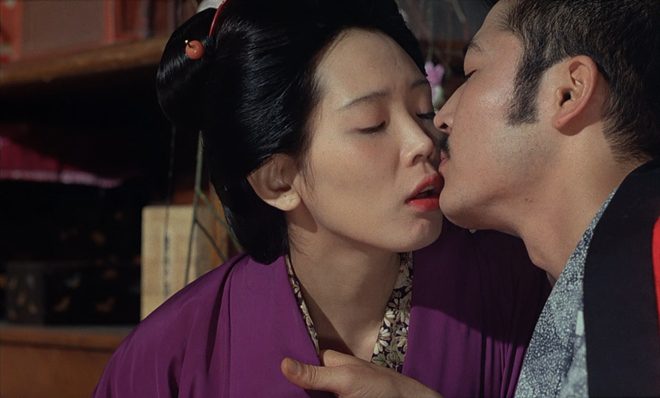In the Realm of the Senses (Ai no Corrida), a Japanese film released in 1976, is not only a cinematic work but also a significant cultural artifact. Directed by Nagisa Oshima—an avant-garde figure of the new wave in Japan—this film pushes the boundaries of artistic expression with its daring visuals and haunting narrative. Based on the real-life incident involving Sada Abe—a woman who committed murder in Japan during the 1930s—this film delves deeply into the shadows of desire, power, and freedom. Amidst a period in Japan that was grappling with the tension between conservatism and modernity, In the Realm of the Senses boldly challenges every standard and norm. Its journey from erotic imagery to stark psychological exploration is a story of obsession, artistry, and unanswerable questions.
A Story Interwoven with Color and Emotion

In the Realm of the Senses immerses viewers in the tumultuous love affair between Sada, a sex worker, and Kichizo, a married man. Their relationship quickly spirals into an uncontrollable vortex of obsession. Engulfed in increasingly extreme encounters, Sada’s passion leads to Kichizo’s demise when she ultimately strangles him in a fit of fervor—a tragic act that he had subtly invited. In the aftermath, she severed his genitalia, symbolizing a grotesque claim to power over her lover.
The story is not merely fictional; it draws from the real-life events surrounding Sada Abe in 1936 when this woman killed her lover and carried his “trophy” with her for several days before being apprehended. Nagisa Oshima transformed this shocking incident into a profound psychological portrait, depicting desire not just as a physical act but as a form of rebellion against repressive societal norms. Set in Japan during the 1930s, characterized by military aggression and strict moral codes, the backdrop serves as a perfect canvas for Sada and Kichizo’s tragic narrative to unfold like a haunting lament.
The Daring Artistic Style of Director Nagisa Oshima

What sets In the Realm of the Senses apart? It is Oshima’s uncompromising directorial style. The film is infamous for its explicit sexual content, leaving nothing to the imagination, captured without hesitation. Yet, it is not merely a display of sensationalism. Oshima employs intimate angles, natural lighting, and a meticulous aesthetic to transform every scene into a vivid painting that is both realistic and symbolic. The interplay between eroticism and death—a familiar motif in Japanese culture—emerges hauntingly through each frame.
Unlike the contemporaneous pinku eiga (pink film) genre, which primarily catered to titillation, In the Realm of the Senses encapsulates profound philosophical and political reflections. Oshima utilizes explicit sexuality as a vital tool to critique the rigid standards of Japanese society, simultaneously challenging the viewer to confront the most concealed aspects of human existence. This is not just a film; it is a manifesto for creative freedom.
The Controversial Debate on Japanese Soil and Global Impact

Upon its release, In the Realm of the Senses faced severe backlash in Japan. The film was banned entirely in its homeland, forcing Oshima to relocate to France to complete his vision. He even faced legal action for “obscenity,” yet Oshima triumphed, establishing the artistic value of the work. This legal battle was not merely a personal victory; it was a breakthrough for artistic expression in Japanese cinema.
Contrary to the hostile reception at home, the film received a warm welcome at international film festivals, notably Cannes in 1976. Here, it sparked a significant debate: where is the line between artistic expression and pornography? The film’s influence extends beyond its time, inspiring future filmmakers to explore eroticism as a medium for profound expression. Culturally, In the Realm of the Senses reflects the struggle between individual freedom and societal pressure—a theme that resonates even today.
Obsession: Liberation or Destruction?

The heart of In the Realm of the Senses lies in the complex relationship between Sada and Kichizo—a tale of love intertwined with a struggle for power. Initially, Sada is the one who submits, yet as the story unfolds, she transforms into a figure of defiance, while Kichizo becomes a passive recipient of her desires, even to the point of self-sacrifice. This role reversal challenges the traditional norms of Japanese society, where women are often viewed as subservient.
The obsession depicted in the film is not merely a desire for physical connection; it is a manifestation of possession, a toxic intertwining that renders both characters unable to exist independently. Kichizo’s death and Sada’s final act become a testament to this truth. Through their story, Oshima poses a profound question: Does despair ultimately lead humanity to liberation, or does it spiral into a vortex of destruction? The film refrains from providing answers, leaving the audience to explore these dilemmas within their own experiences.
The Legacy of a Shocking Masterpiece
In the Realm of the Senses is more than just a provocative film; it is a groundbreaking work that confronts the darker corners of human desire. With Nagisa Oshima’s audacious vision, the film reshaped the perception of eroticism in cinema, opening avenues for discussions on artistic freedom and the boundaries of representation. Over half a century later, its allure and potency remain undiminished. In an increasingly open world, can we view this film as a timeless avant-garde masterpiece, or does it still provoke controversy? There lies the question of its enduring relevance in a society grappling with issues of desire, power, and the essence of freedom.





















